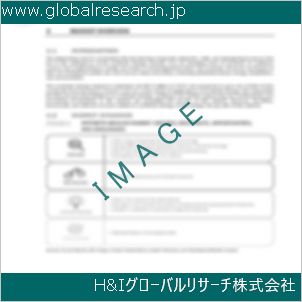Table of Contents
1 Industry Overview of Sodiumhydride
1.1 Definition and Specifications of Sodiumhydride
1.1.1 Definition of Sodiumhydride
1.1.2 Specifications of Sodiumhydride
1.2 Classification of Sodiumhydride
1.3 Applications of Sodiumhydride
1.3.1 Nuclear Application
1.3.2 Non-Nuclear Application
1.4 Industry Chain Structure of Sodiumhydride
1.5 Industry Overview and Major Regions Status of Sodiumhydride
1.5.1 Industry Overview of Sodiumhydride
1.5.2 Global Major Regions Status of Sodiumhydride
1.6 Industry Policy Analysis of Sodiumhydride
1.7 Industry News Analysis of Sodiumhydride
2 Manufacturing Cost Structure Analysis of Sodiumhydride
2.1 Raw Material Suppliers and Price Analysis of Sodiumhydride
2.2 Equipment Suppliers and Price Analysis of Sodiumhydride
2.3 Labor Cost Analysis of Sodiumhydride
2.4 Other Costs Analysis of Sodiumhydride
2.5 Manufacturing Cost Structure Analysis of Sodiumhydride
2.6 Manufacturing Process Analysis of Sodiumhydride
3 Technical Data and Manufacturing Plants Analysis of Sodiumhydride
3.1 Capacity and Commercial Production Date of Global Sodiumhydride Major Manufacturers in 2023
3.2 Manufacturing Plants Distribution of Global Sodiumhydride Major Manufacturers in 2023
3.3 R&D Status and Technology Source of Global Sodiumhydride Major Manufacturers in 2023
3.4 Raw Materials Sources Analysis of Global Sodiumhydride Major Manufacturers in 2023
4 Capacity, Production and Revenue Analysis of Sodiumhydride by Regions, Types and Manufacturers
4.1 Global Capacity, Production and Revenue of Sodiumhydride by Regions 2019-2024
4.2 Global and Major Regions Capacity, Production, Revenue and Growth Rate of Sodiumhydride 2019-2024
4.3 Global Capacity, Production and Revenue of Sodiumhydride by Types 2019-2024
4.4 Global Capacity, Production and Revenue of Sodiumhydride by Manufacturers 2019-2024
5 Price, Cost, Gross and Gross Margin Analysis of Sodiumhydride by Regions, Types and Manufacturers
5.1 Price, Cost, Gross and Gross Margin Analysis of Sodiumhydride by Regions 2019-2024
5.2 Price, Cost, Gross and Gross Margin Analysis of Sodiumhydride by Types 2019-2024
5.3 Price, Cost, Gross and Gross Margin Analysis of Sodiumhydride by Manufacturers 2019-2024
6 Consumption Volume, Consumption Value and Sale Price Analysis of Sodiumhydride by Regions, Types and Applications
6.1 Global Consumption Volume and Consumption Value of Sodiumhydride by Regions 2019-2024
6.2 Global and Major Regions Consumption Volume, Consumption Value and Growth Rate of Sodiumhydride 2019-2024
6.3 Global Consumption Volume and Consumption Value of Sodiumhydride by Types 2019-2024
6.4 Global Consumption Volume and Consumption Value of Sodiumhydride by Applications 2019-2024
6.5 Sale Price of Sodiumhydride by Regions 2019-2024
6.6 Sale Price of Sodiumhydride by Types 2019-2024
6.7 Sale Price of Sodiumhydride by Applications 2019-2024
6.8 Market Share Analysis of Sodiumhydride by Different Sale Price Levels
7 Supply, Import, Export and Consumption Analysis of Sodiumhydride
7.1 Supply, Consumption and Gap of Sodiumhydride 2019-2024
7.2 Global Capacity, Production, Price, Cost, Revenue, Supply, Import, Export and Consumption of Sodiumhydride 2019-2024
7.3 USA Capacity, Production, Price, Cost, Revenue, Supply, Import, Export and Consumption of Sodiumhydride 2019-2024
7.4 EU Capacity, Production, Price, Cost, Revenue, Supply, Import, Export and Consumption of Sodiumhydride 2019-2024
7.5 China Capacity, Production, Price, Cost, Revenue, Supply, Import, Export and Consumption of Sodiumhydride 2019-2024
7.6 Japan Capacity, Production, Price, Cost, Revenue, Supply, Import, Export and Consumption of Sodiumhydride 2019-2024
8 Major Manufacturers Analysis of Sodiumhydride
8.1 Manufacturer One
8.1.1 Company Profile
8.1.2 Product Picture and Specifications
8.1.2.1 Type I
8.1.2.2 Type II
8.1.2.3 Type III
8.1.3 Capacity, Production, Price, Cost, Gross and Revenue
8.1.4 Contact Information
8.2 Manufacturer Two
8.2.1 Company Profile
8.2.2 Product Picture and Specifications
8.2.2.1 Type I
8.2.2.2 Type II
8.2.2.3 Type III
8.2.3 Capacity, Production, Price, Cost, Gross and Revenue
8.2.4 Contact Information
8.3 Manufacturer Three
8.3.1 Company Profile
8.3.2 Product Picture and Specifications
8.3.2.1 Type I
8.3.2.2 Type II
8.3.2.3 Type III
8.3.3 Capacity, Production, Price, Cost, Gross and Revenue
8.3.4 Contact Information
8.4 Manufacturer Four
8.4.1 Company Profile
8.4.2 Product Picture and Specifications
8.4.2.1 Type I
8.4.2.2 Type II
8.4.2.3 Type III
8.4.3 Capacity, Production, Price, Cost, Gross and Revenue
8.4.4 Contact Information
8.5 Manufacturer Five
8.5.1 Company Profile
8.5.2 Product Picture and Specifications
8.5.2.1 Type I
8.5.2.2 Type II
8.5.2.3 Type III
8.5.3 Capacity, Production, Price, Cost, Gross and Revenue
8.5.4 Contact Information
…
9 Marketing Trader or Distributor Analysis of Sodiumhydride
9.1 Marketing Channels Status of Sodiumhydride
9.2 Traders or Distributors with Contact Information of Sodiumhydride by Regions
9.3 Ex-work Price, Channel Price and End Buyer Price Analysis of Sodiumhydride
9.4 Regional Import, Export and Trade Analysis of Sodiumhydride
10 Industry Chain Analysis of Sodiumhydride
10.1 Upstream Major Raw Materials Suppliers Analysis of Sodiumhydride
10.1.1 Major Raw Materials Suppliers with Contact Information Analysis of Sodiumhydride
10.1.2 Major Raw Materials Suppliers with Supply Volume Analysis of Sodiumhydride by Regions
10.2 Upstream Major Equipment Suppliers Analysis of Sodiumhydride
10.2.1 Major Equipment Suppliers with Contact Information Analysis of Sodiumhydride
10.2.2 Major Equipment Suppliers with Product Pictures Analysis of Sodiumhydride by Regions
10.3 Downstream Major Consumers Analysis of Sodiumhydride
10.3.1 Major Consumers with Contact Information Analysis of Sodiumhydride
10.3.2 Major Consumers with Consumption Volume Analysis of Sodiumhydride by Regions
10.4 Supply Chain Relationship Analysis of Sodiumhydride
11 Development Trend of Analysis of Sodiumhydride
11.1 Capacity, Production and Revenue Forecast of Sodiumhydride by Regions and Types
11.1.1 Global Capacity, Production and Revenue of Sodiumhydride by Regions 2024-2029
11.1.2 Global and Major Regions Capacity, Production, Revenue and Growth Rate of Sodiumhydride 2024-2029
11.1.3 Global Capacity, Production and Revenue of Sodiumhydride by Types 2024-2029
11.2 Consumption Volume and Consumption Value Forecast of Sodiumhydride by Regions, Types and Applications
11.2.1 Global Consumption Volume and Consumption Value of Sodiumhydride by Regions 2024-2029
11.2.2 Global and Major Regions Consumption Volume, Consumption Value and Growth Rate of Sodiumhydride 2024-2029
11.2.3 Global Consumption Volume and Consumption Value of Sodiumhydride by Types 2024-2029
11.2.4 Global Consumption Volume and Consumption Value of Sodiumhydride by Applications 2024-2029
11.3 Supply, Import, Export and Consumption Forecast of Sodiumhydride
11.3.1 Supply, Consumption and Gap of Sodiumhydride 2024-2029
11.3.2 Global Capacity, Production, Price, Cost, Revenue, Supply, Import, Export and Consumption of Sodiumhydride 2024-2029
11.3.3 USA Capacity, Production, Price, Cost, Revenue, Supply, Import, Export and Consumption of Sodiumhydride 2024-2029
11.3.4 EU Capacity, Production, Price, Cost, Revenue, Supply, Import, Export and Consumption of Sodiumhydride 2024-2029
11.3.5 China Capacity, Production, Price, Cost, Revenue, Supply, Import, Export and Consumption of Sodiumhydride 2024-2029
11.3.6 Japan Capacity, Production, Price, Cost, Revenue, Supply, Import, Export and Consumption of Sodiumhydride 2024-2029
12 New Project Investment Feasibility Analysis of Sodiumhydride
12.1 New Project SWOT Analysis of Sodiumhydride
12.2 New Project Investment Feasibility Analysis of Sodiumhydride
13 Conclusion of the Global Sodiumhydride (CAS 7646-69-7) Industry 2024 Market Research Report
| ※参考情報 水素化ナトリウム(Sodium hydride)は、化学式 NaH で表される無機化合物です。無色の固体であり、空気中では酸化されやすく、水分と反応して水素ガスを発生します。この化合物は1980年代から広く利用されており、その特性や用途について知ることは化学分野での研究や産業での利用において非常に重要です。 水素化ナトリウムの定義としては、ナトリウムと水素の化合物であり、金属ナトリウムが水素と反応することで生成されます。一般に強い還元剤として知られ、アルカリ金属に分類されます。この物質は、高い反応性を持ち、さまざまな化学反応において重要な役割を果たします。 水素化ナトリウムの特徴として、まずその高い反応性が挙げられます。水分と接触すると直ちに反応し、水素ガスを放出します。また、酸と反応することでナトリウム塩を生成することから、強い塩基性を持つことも特徴とされています。さらに、湿気や空気に対して非常に敏感であり、保存や取り扱いには注意が必要です。通常は乾燥した環境で管理され、封止された状態で保存されます。 この化合物にはいくつかの種類がありますが、一般に市販されているのは粉末形態やペレット形態です。粉末形態は特に化学反応において優れた性能を発揮し、多くの実験室や工業用途で使用されています。ペレット形態は扱いやすさが増し、特定のアプリケーションにおいて選ばれることが多いです。 水素化ナトリウムの主な用途の一つは、化学合成における還元剤としての利用です。特に有機化学においては、アルコールやケトンなどの官能基を還元する際に頻繁に使用されます。さらに、グリニャール試薬を生成するための前駆体としても利用されます。これは、特に有機合成において非常に重要な役割を持っています。 また、水素化ナトリウムは、金属としてのナトリウムの特性を維持しながらも、反応性が異なるため、新しい材料やコンポジットの製造に用いられることもあります。これにより、耐腐食性や耐熱性が向上した材料を得ることが可能です。 加えて、水素化ナトリウムはバッテリー技術においても注目されています。特に、ナトリウムイオンバッテリーにおいては、エネルギー密度やサイクルの寿命を向上させるために、有望な材料として研究されています。これにより、再生可能エネルギーの利用促進や持続可能なエネルギー貯蔵の実現が期待されています。 さらに、関連技術としては、ナトリウム水素化物を利用した水素貯蔵技術が挙げられます。水素エネルギーの利用が進む中、水素を効率的に貯蔵・輸送する技術はいっそう重要になってきています。この分野では、水素化ナトリウムのような物質が新たな貯蔵素材として研究されています。 水素化ナトリウムを取り扱う際には、安全性が極めて重要です。この化合物は、強い還元性を持つため、他の化学物質と反応する際には十分な注意が必要です。また、取り扱い時には、適切な防護具の着用や換気の良い場所で作業を行うことが推奨されます。また、万が一の事故に備えて、消火器や水分を用意しておくことも重要です。 総じて、水素化ナトリウムは化学分野で非常に重要な機材であり、その特性や用途は多岐にわたります。化学合成、材料開発、エネルギー技術の分野での利用が進んでいることから、今後もその研究や応用が期待されています。化学者やエンジニアにとって、この物質の理解は極めて重要であり、その特性に基づいた新しい応用が模索され続けることでしょう。 |
❖ 免責事項 ❖
http://www.globalresearch.jp/disclaimer

-gr.jpg)










